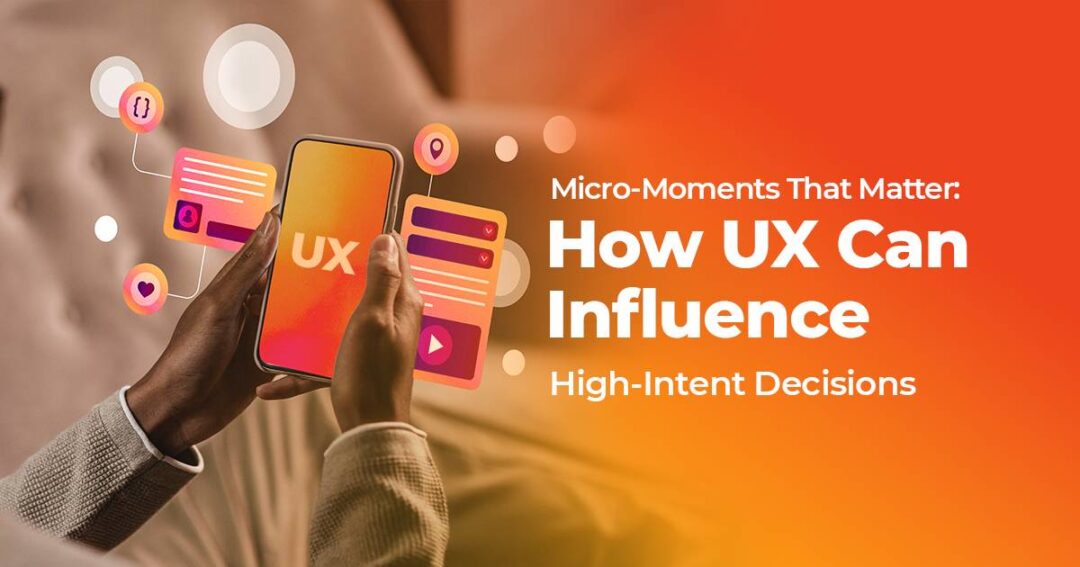Digital interactions today are instant, and users expect answers in the blink of an eye. They act in micro-moments, those tiny windows of time where people turn to their devices to find, learn, or buy something quickly. For businesses, these micro-moments are opportunities to connect with customers at their highest point of intent. When done right, micro moments marketing can drastically shift the course of a user journey.
But here’s the thing: it’s not just about being present. It’s about being useful and seamless. This is where user experience (UX) plays a massive role. Let’s break it down.
Understanding Micro-Moments
Google popularised the term “micro-moments” to describe the split seconds where consumers instinctively grab their phones to solve a problem, explore an interest, or make a purchase. These are decision-heavy moments, often unplanned, and deeply rooted in intent.
In simpler terms, a micro-moment is:
- Intent-rich
- Immediate
- Device-centric (usually mobile)
- Decision-driven
It could be a commuter checking for a nearby coffee shop, or a shopper reading product reviews before clicking “Buy Now.” Each interaction is an opportunity for your brand to show up and deliver.
The Four Key Types of Micro-Moments
- I-want-to-know moments: Users are researching but not ready to buy.
- I-want-to-go moments: Users are looking for local businesses or services.
- I-want-to-do moments: Users want help completing a task.
- I-want-to-buy moments: Users are ready to make a purchase.
Understanding these stages can help in designing a UX strategy that aligns with the user’s intent.
What Are Micro-Moments in UX Design and Why Do They Matter for High-Intent Decisions?
From a UX perspective, micro-moments in digital marketing are not just opportunities to serve content. They’re chances to build trust and reduce friction. When your site or app anticipates user needs in these moments, you’re not just guiding behaviour — you’re nudging them toward high-intent decisions.
High-intent decisions are choices made with clear purpose — think of a user comparing prices before booking a hotel. A smart, intent-driven UX ensures:
- Faster load times
- Easy navigation
- Contextual call-to-actions (CTAs)
- Personalised content delivery
Fail to meet expectations in these moments, and the user bounces. Worse, they go to your competitor.
How Does User Experience Influence Customer Decisions During Micro-Moments?
User experience directly impacts how a user behaves during micro-moments. A seamless UX anticipates needs and eliminates unnecessary steps.
Let’s say a user searches for “best electric razors under 2000/-.” They land on your page, and within seconds:
- They see a list of options with prices
- There’s a comparison chart
- There’s a short buying guide tailored for Indian shoppers
- A CTA says, “Buy Now, Get Next-Day Delivery”
All of this, without scrolling too much. That’s a winning UX.
Moreover, behavioural psychology influences UX decisions during micro-moments. Clear visuals, smart positioning of CTAs, and emotional cues (like reviews or star ratings) reduce decision fatigue. It makes action feel natural.
How Micro-Moments Impact Conversion Rates in Digital Products
Conversion isn’t magic — it’s design plus timing. Micro-moments accelerate conversions when users find exactly what they need, without delay.
A few ways micro-moments impact conversions:
- They reduce time-to-purchase
- Encourage impulse buys
- Increase trust in the brand
- Drive repeat engagement
For example, an app that lets users track fitness goals will retain more users if it shows “Today’s Progress” immediately on login. That’s addressing a micro-moment of “I-want-to-know.”
In micro moments customer journey, each step is a conversion opportunity, but only if the UX is primed to respond with speed, relevance, and ease.
5 Ways UX Can Influence High-Intent Decisions
- Predict and Prepare for High-Intent Touchpoints
Use analytics to identify high-intent decision points in the user journey. These might be pricing pages, reviews, or mobile search results. Refine these areas with tighter design, clearer copy, and intuitive actions. - Mobile-First Design
Most micro-moments happen on mobile. Responsive design, fast loading, and finger-friendly navigation aren’t optional — they’re expected. - Minimal Distractions, Maximum Clarity
Micro-moment users are in a rush. Avoid pop-ups, overuse of sliders, or unnecessary steps. Use contrast, spacing, and headings wisely to reduce cognitive load. - Real-Time Personalisation
Show content that matches the user’s intent. If someone has searched for “affordable hiking boots,” show budget-friendly options first. That’s intent-driven UX in action. - Track the Right Metrics
It’s essential to measure success. Use metrics to track UX success in micro-moments like:
- Bounce rate
- Time on key pages
- Conversion rate from search
- Scroll depth
- Click-through on CTAs
These insights allow continuous improvement tailored to actual user behaviour.
Final Thoughts: Aligning UX with Micro-Moment Marketing Strategy
Micro-moments are shaping the future of online behaviour. Users expect immediacy and relevance. A slow, confusing interface won’t just frustrate them — it’ll cost you revenue.
By aligning UX principles with micro moments marketing, brands can meet users at their highest point of intent and guide them toward meaningful action.
Whether you’re building a product, managing an eCommerce store, or running a local service business it’s time to rethink how your UX supports high-intent decisions in real-time.
Need help creating a seamless user journey that converts during micro-moments?
Contact us today to optimise your UX and unlock the full potential of your digital presence. Don’t let micro moments marketing opportunities pass you by, start optimising now!


